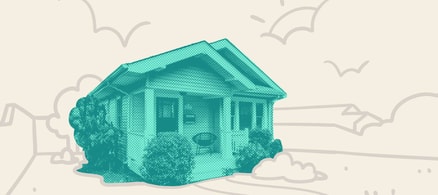1. Sharpen your credit score

Though market forces drive mortgage rates up or down, lenders also consider your own finances when setting your rate. Generally, a high credit score signals that lending to you is less risky. A score above 700 can help you qualify for a mortgage, negotiate the best loan terms and get plenty of loan options.
Making even a small improvement in your credit score can yield major savings.
In 2020, increasing your score from 679 to 680 could slash your APR, or annual percentage rate (mortgage rate plus other lender costs), on a 30-year, $300,000 loan from about 3.10% down to 2.89%.
Your monthly payment would be reduced by $34 — meaning $12,240 in savings over the life of a 30-year fixed-rate mortgage.
Check your credit score — which you can do for free — and credit reports at least six months ahead of applying for a mortgage.
As many as a quarter of consumers have potentially harmful mistakes on their credit reports, according to a Federal Trade Commission study. Go to work on getting the errors fixed, and reduce debt and take other steps to raise your credit score.
If your score is deeply in the doldrums you might want to consider a rent-to-own arrangement. It would allow you to live in a home while you work on your credit score, so you can eventually buy the place.
Stop overpaying for home insurance
Home insurance is an essential expense – one that can often be pricey. You can lower your monthly recurring expenses by finding a more economical alternative for home insurance.
SmartFinancial can help you do just that. SmartFinancial’s online marketplace of vetted home insurance providers allows you to quickly shop around for rates from the country’s top insurance companies, and ensure you’re paying the lowest price possible for your home insurance.
Explore better rates2. Choose your best mortgage option

Every mortgage has different down payment requirements, eligibility guidelines and special costs. Finding a mortgage best-suited for your needs can help you qualify for a loan or save on costs.
Your main options include:
Conventional loans
A conventional loan is a mortgage that’s not insured or guaranteed by a federal government agency.
Many conventional mortgages are "conforming loans," meaning both you and the loan must meet — or "conform to" — eligibility requirements set by Fannie Mae and Freddie Mae, two government sponsored companies that buy or back most U.S. mortgages.
Borrowers usually need a credit score of at least 620. And, if your down payment is less than 20% of the home’s value, you’ll need to pay private mortgage insurance, or PMI, before you have enough equity. PMI protects the lender until you have more “skin in the game” and are seen as less likely to default on your mortgage.
Making a bigger down payment not only helps you avoid PMI, but it also can score you a lower mortgage rate. Plus, your payments and interest costs will be reduced because you’ll need a smaller loan. You’re paying more upfront.
In 2020, conforming loans can’t exceed $510,400 in most parts of the U.S., or $765,000 in high-cost areas. Mortgages that go over the limits are known as jumbo loans and tend to have higher interest rates and tougher credit requirements.
FHA loans
FHA loans are backed by the Federal Housing Administration and come with looser eligibility requirements. If you put down at least 10%, then you may qualify with a credit score between 500 and 579. With a higher credit score, you can put down as little as 3.5%.
The downside to this type of loan? You’ll need to pay two types of mortgage insurance:
- An upfront mortgage insurance premium, or MIP: 1.75% of the loan amount, paid at closing.
- Annual MIP: 0.45% to 1.05% of the loan amount, paid throughout the life of the loan.
VA loans
VA loans are insured by the Department of Veterans Affairs and are available to military members, veterans and surviving spouses. These loans are a great benefit for people who qualify, because no down payment is required.
Borrowers do pay an upfront funding fee, which ranges between 1.4% and 3.6% of the loan amount, based on whether you’ve taken out a VA loan before or are making any down payment.
USDA loans
USDA loans — guaranteed by the U.S. Department of Agriculture and in some cases are issued directly by the agency — also don’t require down payments, and they come with low interest rates.
Borrowers must meet income restrictions, and the home must be in an eligible rural area — but “rural” is loosely defined. As much as 97% of the land in the U.S. fits the USDA’s description.
3. Decide whether you want a fixed- or adjustable-rate mortgage

As you’re shopping for your mortgage, one of your biggest decisions involves the type of interest rate you want.
Fixed-rate mortgage
As the name implies, fixed interest rates don’t change over the life of the mortgage. They’re good for borrowers who prefer a predictable monthly payment and plan to stay in the home for the long term.
If you can afford a higher monthly payment, then you’ll save by taking out a fixed-rate mortgage with a shorter loan term.
For instance, say you want to buy a $300,000 home and are prepared to put 20% down. You'd need a mortgage in the amount of $240,000.
If you go with a 30-year fixed-rate mortgage — America’s most popular home loan — you might get a 3% interest rate and a monthly payment (principal and interest) of $1,011. You'd pay more than $124,000 in interest over 30 years.
Or, you could choose a 15-year fixed-rate mortgage instead. Those loans have lower interest rates, so yours might be 2.6%. You'd face a stiffer monthly payment of $1,611, but you'd pay just $50,000 in interest over the 15 years.
Adjustable-rate mortgage
Adjustable-rate mortgages, or ARMs, start at low, fixed introductory interest rates. After five to seven years, the rate will reset each year for the rest of the loan term. The rate can rise or fall, following the path of a benchmark interest rate like the prime rate.
An ARM can be a good fit if you don’t think you’ll live in the home for the long haul, you plan to pay off the mortgage quickly, or you think rates will remain low or even drop in the next few years.
Need cash? Tap into your home equity
As home prices have increased, the average homeowner is sitting on a record amount of home equity. Savvy homeowners are tapping into their equity to consolidate debt, pay for home improvements, or tackle unexpected expenses. Rocket Mortgage, the nation's largest mortgage lender, offers competitive rates and expert guidance.
Get Started4. Negotiate favorable loan terms

When you’ve settled on the type of loan you want, then it’s time to shop around for your mortgage and negotiate loan terms with lenders — which is one of the best ways to save on borrowing costs.
Start by checking the current national average mortgage rates, to help you figure out a target range. Then seek rate quotes from multiple lenders, including banks, credit unions and online lenders. Having several options gives you more bargaining power.
Once you’ve gathered several estimates, compare them side by side. Pay close attention to:
- The interest rates. Most lenders align their rates with the market. Though average rates have hit all-time lows in 2020, some lenders can go lower, but some may go higher. That's why comparing offers is so important.
- Closing costs. These are fees you pay the lender at closing, covering various costs of the transaction. Typical closing costs are just shy of $6,000, according to data firm ClosingCorp.
- Discount points. These are optional fees you can pay to lower the interest rate; they're a percentage of your loan amount. "Points" can make financial sense if you plan to stay in the home for the long term.
- APRs. Annual percentage rates take into account lender fees, like points, underwriting fees and loan origination fees. The APR is typically higher than the interest rate.
Lenders want your business, so they may be willing to lower your interest rate or trim a few costs if you ask. Once you’ve gone through the quotes, take the best offer and ask your preferred lender to match the terms (if that lender hasn't already made the most appealing offer).
Remember to use your comparison shopping tactics when it comes time to buy your home insurance policy. Get premium quotes from several insurers and review the policies side by side to find the best deal in the bunch.
5. Get a mortgage preapproval

After you’ve found an ideal lender and loan, one last step before you start house shopping is to get a mortgage preapproval. It’s a letter from the lender that establishes you've got the financial resources to take out a mortgage and shows how much home you can afford.
This helps you shop within your budget — and can give you a competitive edge when bidding for a home. Sellers know you’re a serious buyer because you already have a lender on board.
During the preapproval process, you fill out a mortgage application, and the lender will pull your credit, evaluate your finances and verify the funds you plan to use at closing. You’ll want to have these documents ready:
- Two months’ worth of bank statements.
- You two most recent pay stubs.
- Your most recent tax return.
- Your most recent W-2 wage and tax statement from your employer.
Once you’re preapproved, you can shop for the home of your dreams and put in a good offer.
6. Lock in your rate

When you’ve found the perfect home and your offer has been accepted, you’ll want to ask the lender for a rate lock. This is a guarantee that your interest rate won’t rise before you close on the home loan.
If you lock the rate and market interest rates rise, you still get to hold onto your lower rate. But it’s a bit of a gamble because you lose out if you lock a rate and mortgage rates fall.
If you decide to lock in your rate, then ask whether the lender will charge you a fee for the privilege, and be sure to get the rate lock in writing.
By taking these steps — improving your credit, negotiating the loan terms and choosing the best loan for your situation — you have a better chance at qualifying for a mortgage. Plus, you might avoid overpaying for your loan by thousands of dollars over time.
Sponsored
Follow These Steps if you Want to Retire Early
Secure your financial future with a tailored plan to maximize investments, navigate taxes, and retire comfortably.
Zoe Financial is an online platform that can match you with a network of vetted fiduciary advisors who are evaluated based on their credentials, education, experience, and pricing. The best part? - there is no fee to find an advisor.







